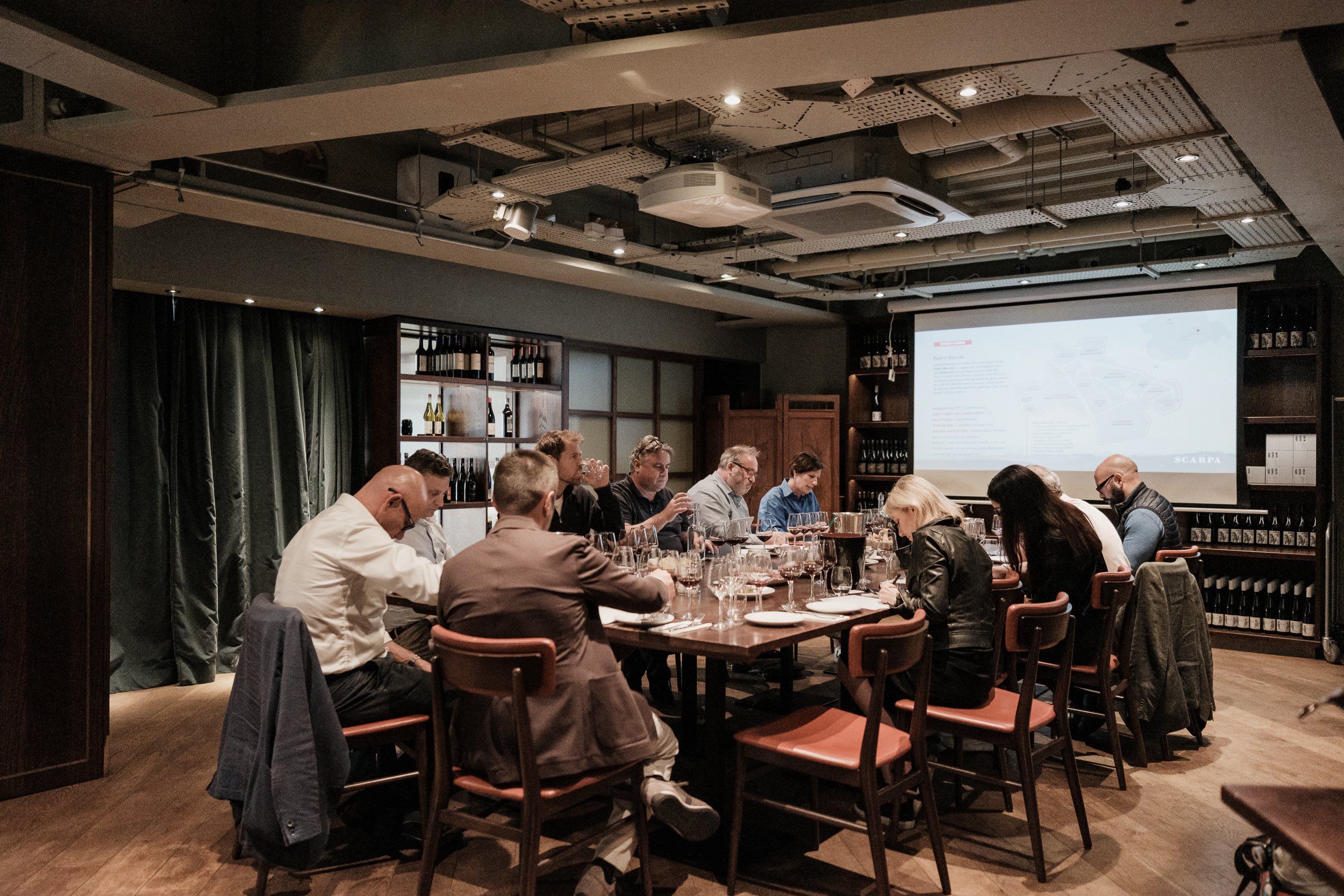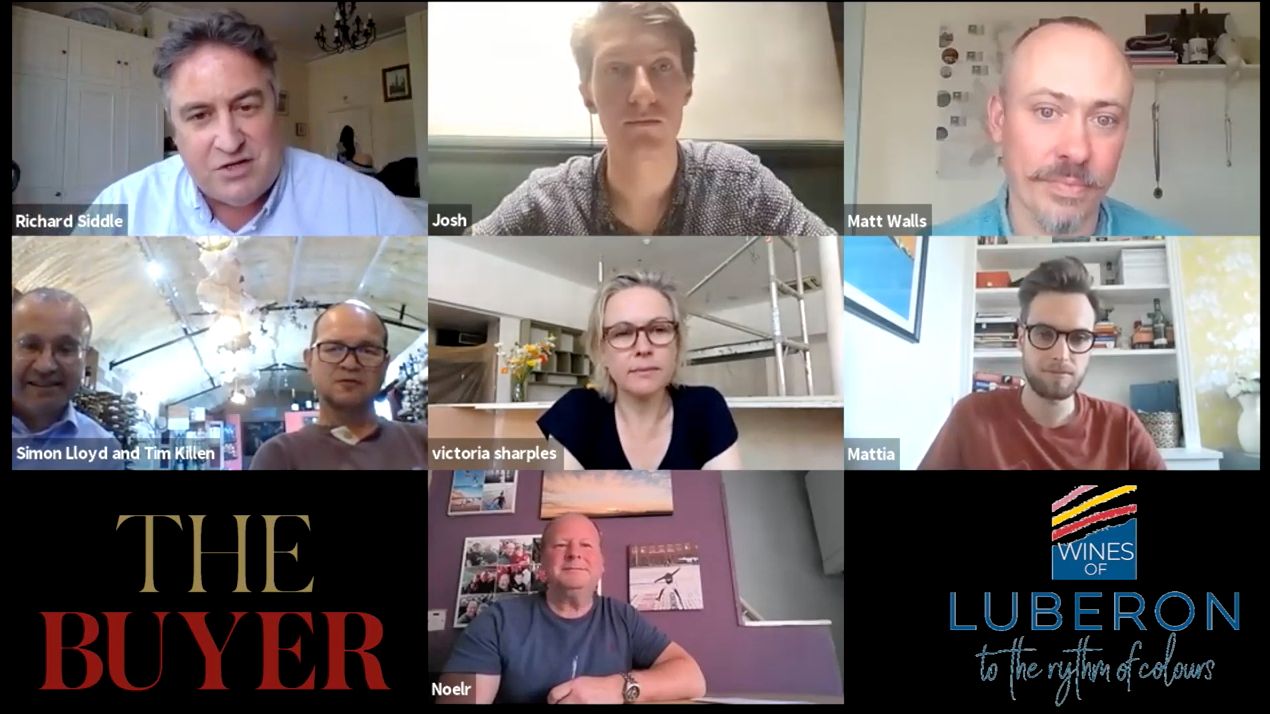In such a competitive and saturated premium wine market it can be hard to find new topics and areas for debate to excite and interest busy wine buyers, merchants and sommeliers. So it was interesting to see how quickly our panel jumped at the chance to take part in a debate - and tasting - looking at the opportunities for fine, heritage and aged Italian white wines. An opportunity to explore what is still, surprisingly, such a small part of the overall Italian wine market.
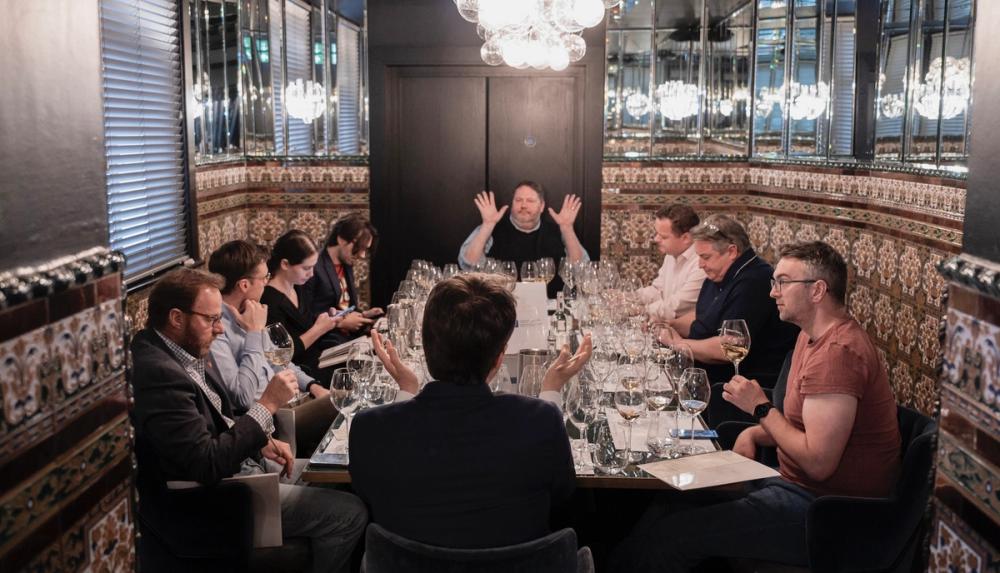
It was a rare opportunity for leading wine buyers to do a wide and varied tasting of aged Italian white wines
It is anything but a niche part of the wines being produced by Villa Bogdano 1880, as it is firmly committed to making and promoting quality aged white wines from its ancient vineyards on its centuries-old estate in north east Veneto just outside Venice. A producer focused on working with its soils, vines and unique climate to make quality, distinctive white - and red - wines from the Lison di Portogruaro region situated between the Alps and the Adriatic coast.
Not many Italian producers, for example, can claim that out of its 106 hectares of vines, 18 are defined as historic, including 117 vines of Tocai Friulano that date back to the end of the 19th century. It also has vineyard plots of Tocai Friulano dating back to the 1940s and 1950s.
But all of its viticultural history could have been lost if it was not for the vision and commitment of Domenico Veronese and his team who took over the property in 2016 and saved it from being turned over into an “intensively farmed monoculture vineyard”.
It has instead done all it can to build on its certified organic status, since 1993, with widespread biodiversity initiatives that care as much for its burgeoning wildlife as it does its historic vines. It is now designated as a “Site of Community Importance” for its preservation of biodiversity and the property sits on the edge of lowlands woods that date back to 1200. Under Veronese’s leadership the property has become an “oasis” for vulnerable species, including yellow-bellied toads, northern crested newts, European pond turtles and a home for many species of birds.

The range of Villa Bogdano aged wines that were part of the tasting
All of which has helped it produce a range of aged Italian white wines it believes can act as a benchmark for other producers to follow. “We know Italian wine is a saturated market, which is why try and do things in a different manner and focus on the grape varieties where we come from,” he said. “We also want to respect the climate where the grapes come from. To give vines and their root system the time to grow. Varieties that have developed and built up a resistance to where they are grown and are sustainable because of that.”
It’s an approach that is working around 85% of the 26,000 bottles it produces now exported around the world with key markets in the US, Sweden, Finland, Switzerland and Germany.
Which is why Veronese and Villa Bogdano teamed up with The Buyer in order to assess what interest there is in the trade to buy these type of wines. To help we pulled together the following panel:
- Sara Danese, international wine trader and investment analyst with a particular focus on building wine sales in China with e-commerce and fine wine writer.
- Joe Wadsack, wine broadcaster, consultant and wine judge who runs his own YouTube channel, The Drinks Coach.
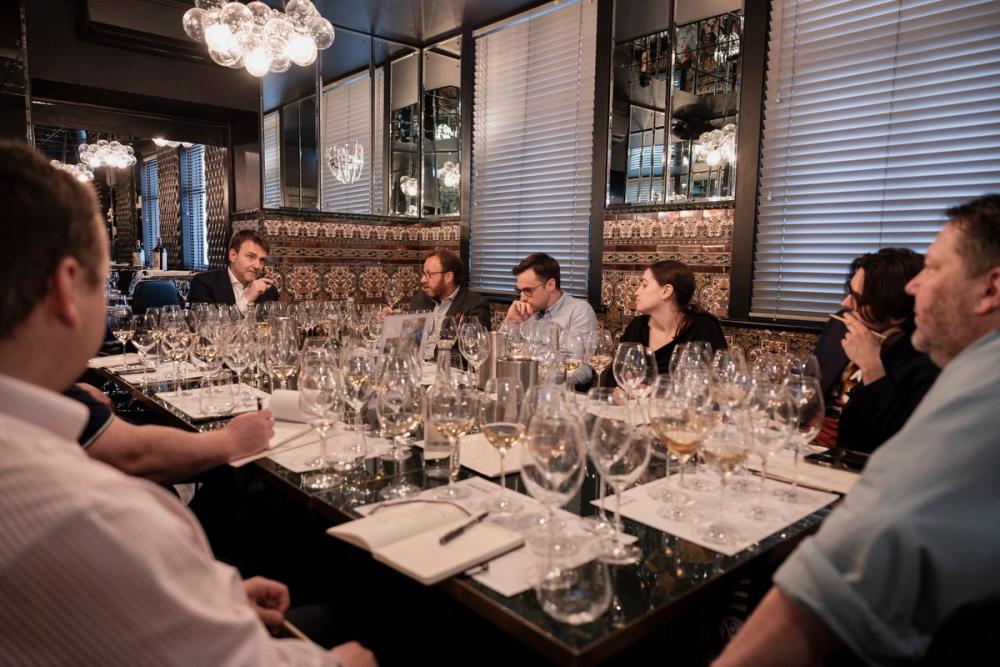
The panel featured leading wine merchants and importers
- Nelson Pari, experienced sommelier, and ex-67 Pall Mall wine buyer who has helped define and build the exciting Italian wine range at Swig Wines.
- Greg Sherwood MW, fine wine director at Museum Wines with an extensive career in fine wine, formerly at Hanford Wines.
- Tom Illsley, managing director, Theatre of Winewith three shops in London that has helped build up an eclectic range of wines from classic European wine countries and regions.
- Sergio de Luca, buying director at Enotria&Coe, who has an extensive buying record of Italian wines from across the country for the UK market.
- Mattia Scarpazza, wine consultant and experienced sommelier who headed up wine at Petersham Nurseries and was most recently at 67 Pall Mall.
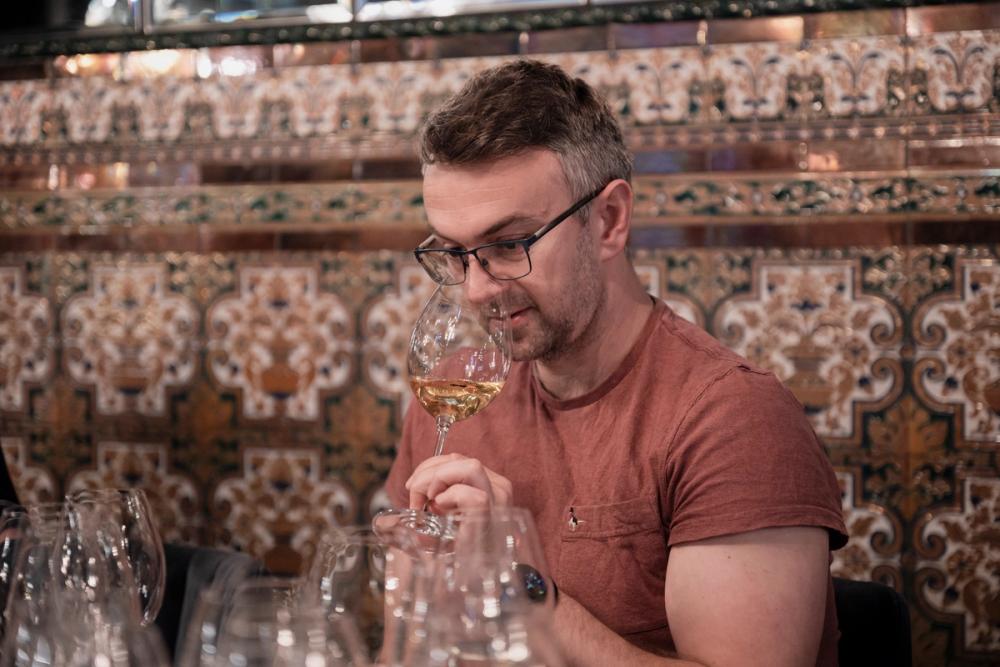
Will Hill of Novel Wines
- Will Hill, managing director, Novel Wines that specialises in sourcing wines from off the beaten track, particularly in Eastern Europe.
- Domenico Veronese, founder and owner of Villa Bogdano 1880.
All of the panel were united from the off. Yes, they are and would be interested in quality, premium aged white wines from Italy. If they could find them.
Sergio de Luca, who could not join the panel in person on the day, was keen to give his backing: “This is something that I really encourage. I have seen a trend in the past few years of white wines that are sold with some age and not just a month after the harvest. We at Enotria are one of the main importers to believe strongly in Timorasso, but also, we have seen a good success with Carricante in Etna. We are also pushing a Lugana Riserva from Ottella in the North Eastern Italy. Their structures give them a chance to get better with age.”
Tom Illsley said Theatre of Wine had recently trebled its Italian wine range and would welcome the opportunity to taste and potentially buy aged Italian white wines but highlighted “the lack of fine Italian whites in the market”.
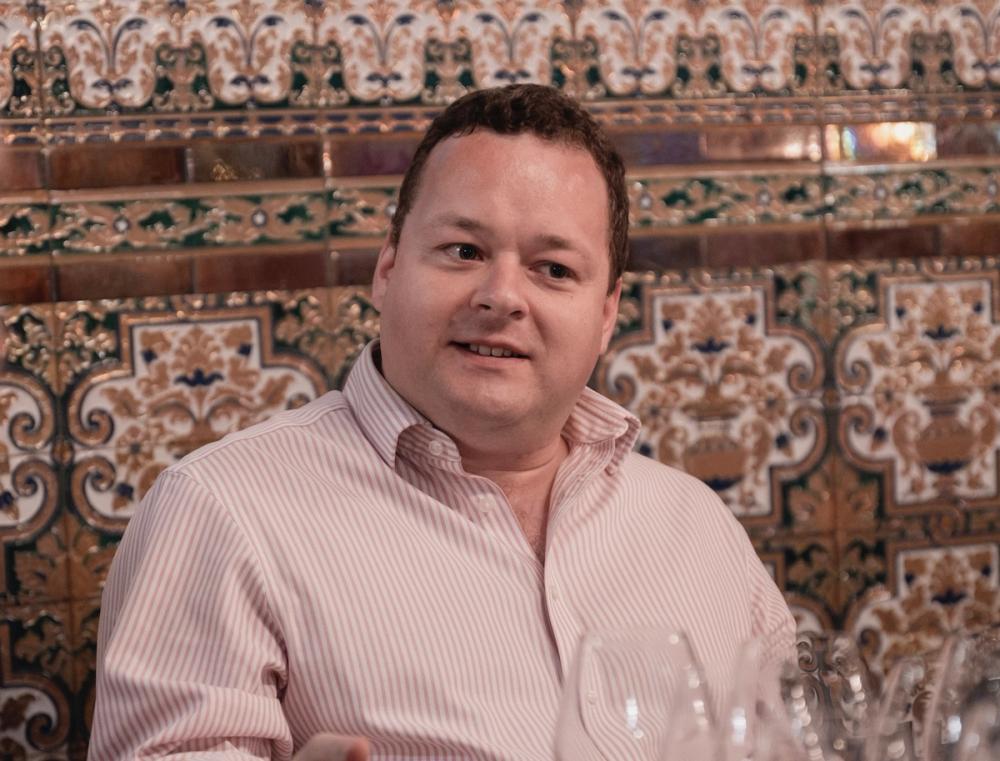
Theatre of Wine's Tom Illsley says he struggles to find enough fine white wine in Italy
He explained: “There is not enough fine wine from Italy. Most of the white Italian wines one encounters are simply meant for easy, immediate consumption. That said, any great wine should age and there must be the potential to make great white wine in Italy. Personally, Etna is where I see the greatest opportunity, but equally top Soave like Inama Foscarino has always shown class with a few years age and more structured wines like Emidio Pepe Trebbiano and the likes of Skerk in Friuli are magnificent examples of fine structured white wines from Italy that command a cult following.”
Greg Sherwood MW said Museum Wines and its customers were both interested and excited about Italian wines so the door is very much open for its fine wines. “But the problem you have with Italian white wines is they have a very loyal local appeal,” he said. “Then when people ask about the grape variety, it might be one of Italy’s most well known ones that does not have the appeal of say a Chenin Blanc or more classic grape variety.”
Nelson Pari said he liked the idea of aged Italian white wines, but doubted anyone could name more than 10 that are available in the market, particularly when compared to what is coming out of South Africa or Margaret River.
He said it was “a double-edged sword between how exotic it is to discover unknown varieties against how much it could sell”. He added: “The main edge these wines can have is all on price point. Unfortunately Italy is already too expensive to compete with South Africa or Australia.”
Sara Danese, who switched from a financial analyst career into running her own wine consultancy and export business selling wine into China, said the issue Italian fine wines have is you need to know the producer to really understand the quality of its wines. You can’t rely on people’s knowledge about a particular DOCG, like you can with Burgundy. “You don’t have that Grand Cru status,” she said. “When you have a DOCG there is such a mix of wines and you are not too sure what the differences are between IGT and DOCG.”
Opportunity for aged wines

The buyers had mixed views on the idea of an aged wine as a particular selling point. Illsley said “There is always room for something good. If it is a wine of fine structure that benefits from a little age, that is great. I don't see age per se as anything other than indifferent, but I think it is axiomatic that a great wine must go beyond the easy pleasure of youth.”
Pari could certainly see a place for Villa Bogdano’s style of aged white wines, but questioned how well known the Lison DOCG is to cut through. It ultimately comes down to “price and quality”, he stressed.
Illsely agreed: “It’s just quality and price. I am sure consumers would be very happy to drink anything provided it was excellent value. If a wine is aimed at the mass market, it must do much more to create a brand identity both for itself and for its region or appellation. The success of Lugana relative to Custoza is a good example of this, but for fine wine I think it is much more important to have a good importer who understands the wine and to think about where you want the wines to be seen and how to get them there.”
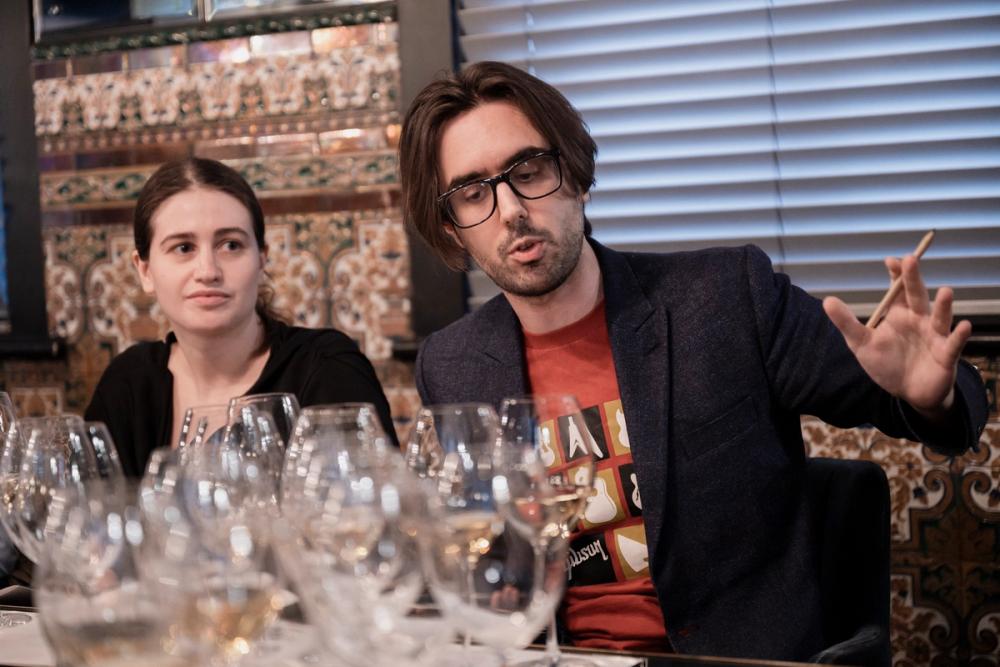
Sara Danese and Swig's Nelson Pari
He argued an increase in aged Italian white wine sales will also require in change in attitude and understanding of Italian wines in general. He explained: “One of the main reasons Italy has been particularly successful on white wines is their neutrality. They are easy drinking, nice, light, fresh and fruity. Those kinds of wines have attracted other cuisines, not only the Italian restaurant sector. Neutrality for me is also their main handicap. You drink it and I bet you will not remember what wine you got.”
He added: “In famous growing areas that command a premium, like Soave, I think a move towards structure and a sense of terroir is crucial going forward. Too many of these wines simply test of the chemistry kit, of esters, cold fermentation and selected yeasts. Such wines could come from anywhere and if they are going to do anything towards establishing a region's credibility they have to aim higher.”
Even in such a well know region as Gavi it is hard to find any wines that are older than 10 years old, said Danese.

Joe Wadsack said the challenge was to re-educate consumers to want to drink aged wines
Wadsack argued there was a strong demand for “wines with maturity” and there was a lot of people looking for wines with age, even if it was only four to five years old. “The problem is supermarkets have educated us to only drink wine within the last two years,” he added.
Scarpazza said Italy is held back at times by its overall approach to winemaking where it has over planted its most popular varieties. “Richer and aged wines are not as appreciated in Italy where the focus is to sell immediately,” he said.
Sergio de Luca said the lack of aged Italian white wines comes down to the “mentality” of so many Italian producers rushing to get their wines into market. “In the past there was a rush to sell their white wines as soon as the harvest finished. I remember getting Pinot Grigio in bottle in the UK in November, two months after the harvest. It’s also connected with finance and having the space to stock their wines. If you ask for some library of white wines in Italy, there is not much there.”
He was pleased to see producers like Villa Bogdano starting to change this “mentality”. “I think there is space in the UK for these kind of wines,” he said. “I would like more aged whites availability, but at the same time price points have to be taken into consideration, as some are not competitive at all.”
Role for old vines
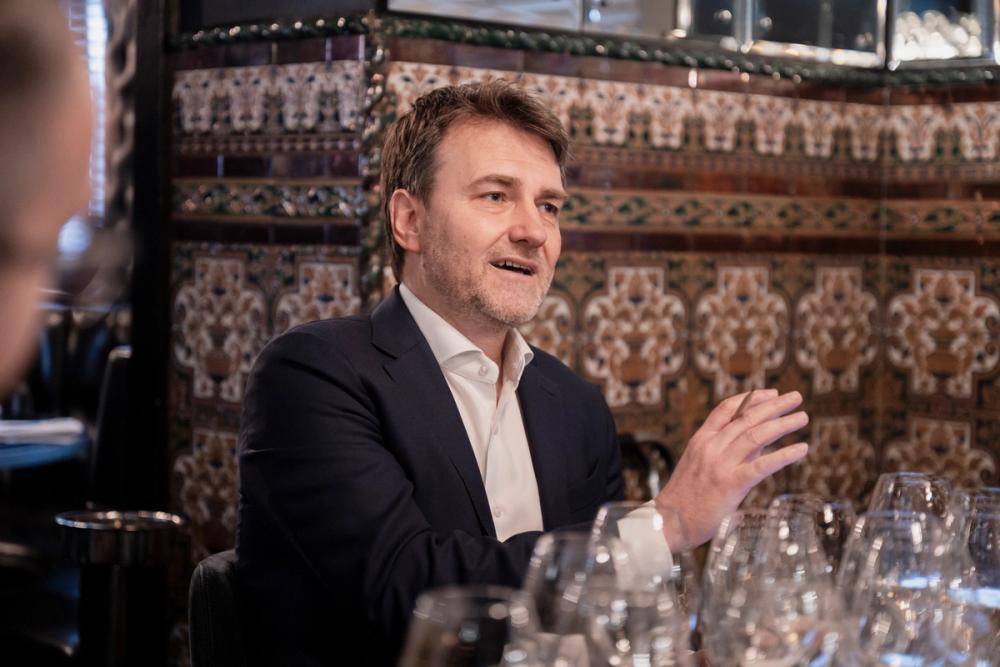
Villa Bogdano's Domenico Veronese was able to share his vision for the winery and the opportunities he thinks there are for aged Italian white wines
Veronese agreed that too many Italian producers “want to speed the process up”. That’s why it is such a supporter of the old vine movement and the Old Vine Conference. “There is a lot of science behind old vines and it is clear they can provide higher quality fruit and make wines that are suitable for ageing.”
But it is becoming increasingly more difficult in Italy to hold on to old vines where producers can get refunds of up to 80% by replanting with new varieties and vines and to follow the modern style of winemaking, he added.
Wadsack said there can be a lot of difference from variety to variety with old vines with some achieving maturity, like Sauvignon Blanc, more quickly than others - depending on the climate. As Italy has so many grape varieties it has a long way to go to fully understand what influence its old vines are having. “But I like the concept. It is protecting the legacy of the vines but I think it is more meaningful in some countries over others - like in Germany. You also need good soils.”
Illsley agreed and felt some regions and countries have a bigger, more credible story to tell around old vines - like in Burgundy and, yes, Germany.
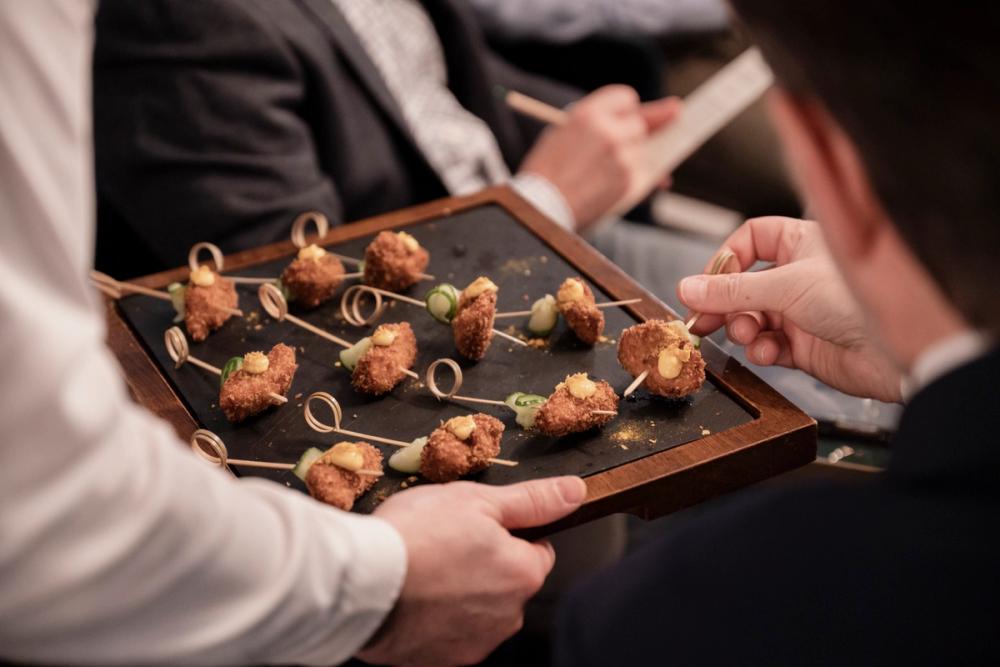
Pairing the wines with Gaucho food was part of the opportunity
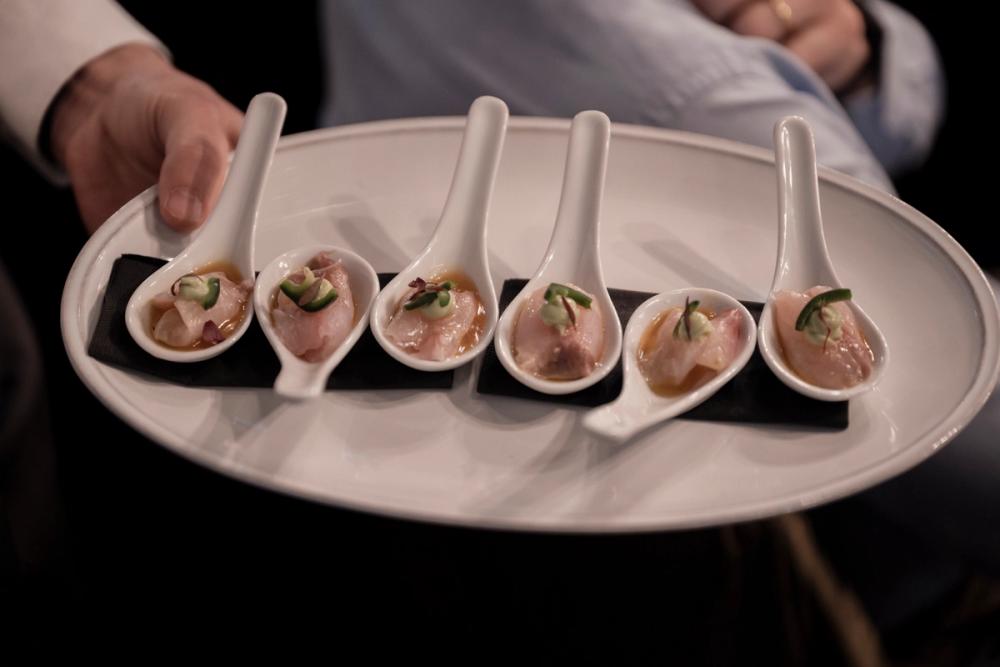

The issue Italy has with old vines, argued Pari, is that not all its old vines make great quality wines, so it is hard and dangerous to generalise.
Veronese said there was an additional attraction and benefit for producers working with old vines.
“It is also promoting sound viticultural practices,” he stressed, as old vines require so much more care and attention. “We spent five years trying to revive the old vines we had on the estate. It takes a long time and needs a lot of support. You have to manage them properly and make sure you do not get stressed vines and they have access to water.”
He added: “You do get to a point where the quality is not getting better with some old vines.”
It’s a difficult balancing act for producers to get right. On the one hand the grapes from old vines need that time to mature, but do consumers really care how old the vine the grapes that have made the wine are?
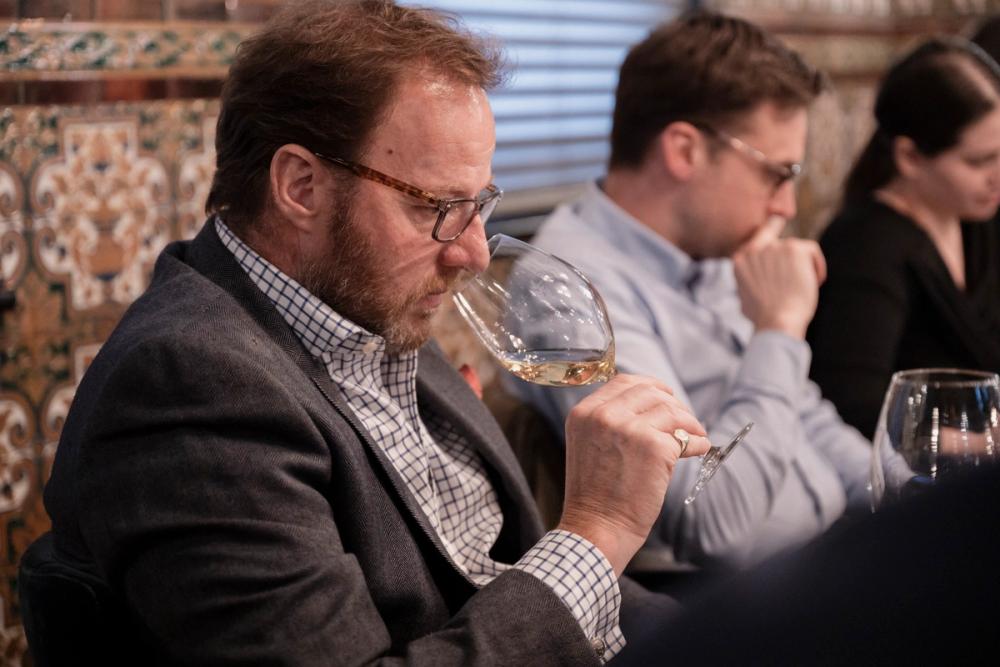
Greg Sherwood said he is always on the look out for aged Italian white wines
Greg Sherwood said that at the fine wine end of the market they will - pointing to the success of so many premium old vine wines from South Africa. “It has been able to build a picture of premium Chenin Blanc from its old vines.”
Illsely said old vines work well if you have a range of wines from the same producer as it can take you further up the pricing ladder. “It gives a different dimension.”
With such a strong South African range at Museum Wines Sherwood said it is already well aware of the opportunities there are with old vines and the styles of wine they can make.
Missed opportunity
Veronese sees a big opportunity for aged Italian wines in the premium on-trade. “There is a big absence of these wines on restaurant wine lists around the world. Italian wines our world famous and Italy can produce great quality white wines from aged grape varieties,” he said.
Pari agreed: “People don’t drink top Italian white wines in Italian restaurants. They prefer to drink Champagne or Chablis. Even a Michelin restaurant in Italy would show off their Burgundy collection.”
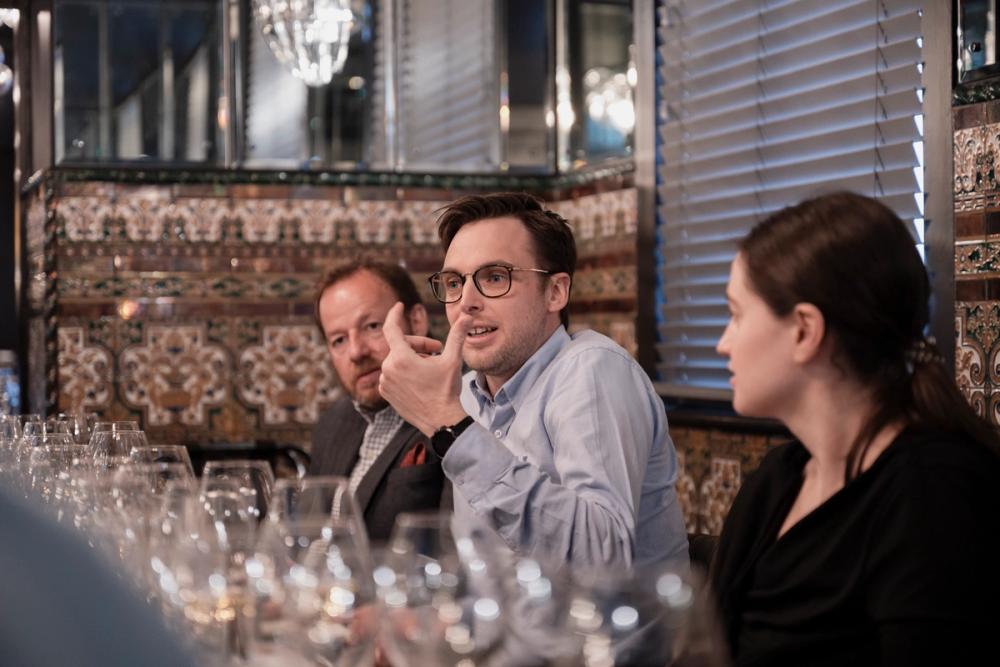
Sommelier Mattia Scarpazza is hugely passionate about aged white wines and was a key part of the panel
Which is a problem for Italy’s white wines. It’s not what the “cool winemakers and cool wine bars” want to make or sell, he added. Scarpazza agreed: “It’s not happening in Italy.”
Sherwood, though, felt there was a chance for the bigger wine distributors to put more of a focus on three to five to year old aged Italian white and red wines in the on-trade and independent wine merchants. “It has to be affordable and available,” he stressed.
“There would be a demand for Italian whites at around £35 on shelf,” agreed Illsely.
Sergio de Luca said: “I would like more aged whites available, but at the same time price points have to be taken into consideration, as some are not competitive at all.”
Tasting and learning
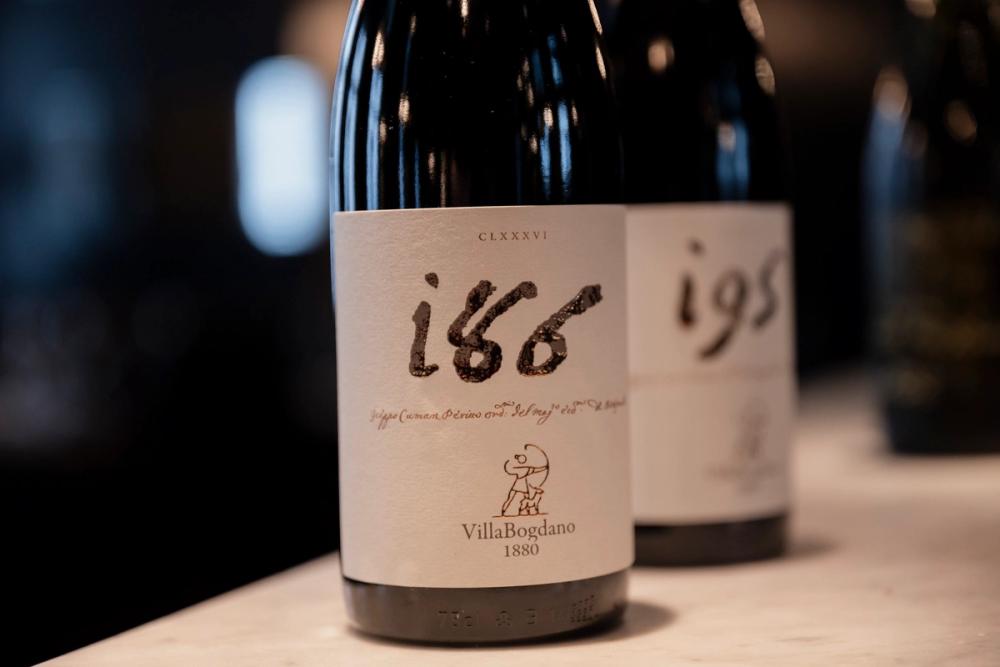
The panel had the opportunity to taste through a range of Villa Bogdano wines including:
Lison Classico DOCG 2021
Lison Classico DOCG 2018
185 Bianco IGT 2018
Cassone Padov Ano 2020
Lison Classico DOCG 2019
187 Chardonnay IGT 2020
186 Refosco D.P.R DOC Riserva 2017
195 Rosso IGT 2017
In terms of the Villa Bogdano wines tasted on the day, Illsley said: “They were well made wines in a rich modern style.”
It was hard, though, to distinguish what makes them different coming from Lison, or a particular style of Fruiliano which means they are going to be judged more on their price than their sense of place.
Pari said the styles of wine “were pointing to the fine wine market” but also questioned how well known the Lison DOCG is.
Wadsack said he has in the past struggled with some styles of Fruliano wine, but found these to be “very different”. “They are all so gastronomic and make you want to have another glass. They feel like very authentic wines. The Lison Classico DOCG 2019 has a little botrytis character present but there was no volatility. It’s a lovely wine.”
Buyers comments
Here are some of the personal comments from the buyers who took part in the debate.
Sara Danese

Sara Danese would love to see more aged Italian white wines in the market
Before the debate what were your thoughts on the opportunities and potential for Italian aged white wines and heritage wines - did these change at all?
Before the debate, my thoughts on the opportunities and potential for Italian aged white wines and heritage wines were cautiously optimistic. I believed that these wines have a unique character and depth that could appeal to wine enthusiasts looking for something distinct from the usual offerings. Italian white wines, particularly those from regions like Friuli, Veneto, Piemonte and Alto Adige, have a rich history and a potential story that can resonate well in markets that appreciate heritage and quality. In contrast, I am afraid that the fragmented nature of Italian wine bureaucracy (Consorzi) isn’t favourable to support winemakers in the efforts of promoting these wines.
What did you think having taken part in the debate?
Taking part in the debate broadened my perspective. It highlighted the specific attributes and stories behind these specific grapes — Friulano, Tocai, Refosco - that I wasn't fully aware of before. I realised the extent to which old vines and unique terroirs contribute to the distinctive profiles of these unique grapes. (I was particularly impressed by the 185 Bianco IGT 2018)
The discussion underscored the growing interest and appreciation for authenticity and heritage in the wine industry, reinforcing the idea that these wines have significant untapped potential and a widespread idea that some of these wines could be great foody wines — so why are white Italian wines notoriously missing from top restaurants?
What do you think gives them a potential edge?
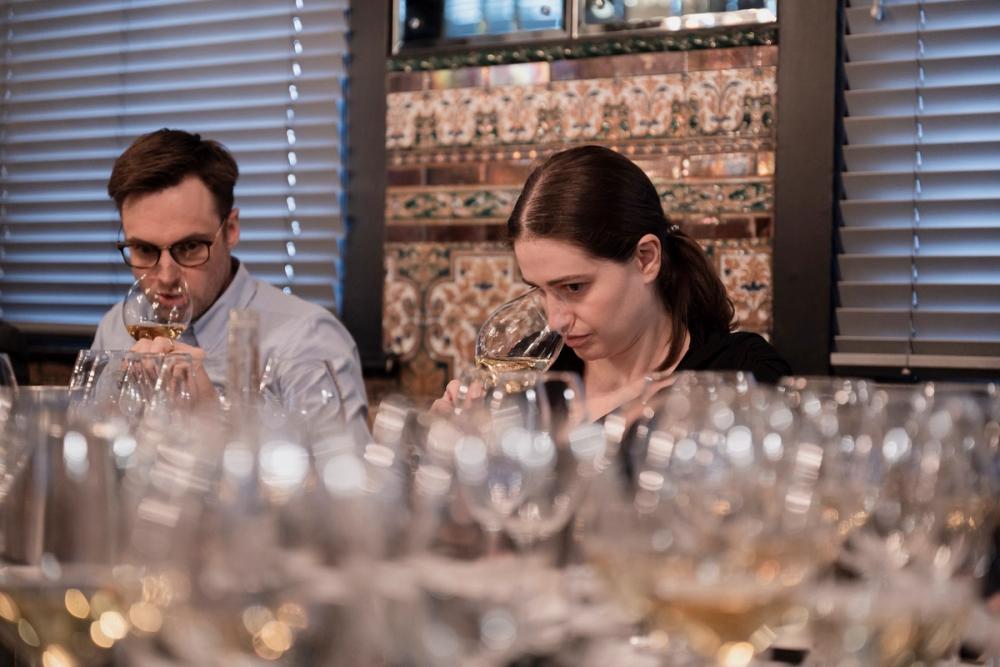
The potential edge for Italian aged white wines and heritage wines lies in their unique stories, terroirs, and production methods. Emphasising their heritage, sustainable practices, and the authenticity of the winemaking process can differentiate these wines in crowded markets.
What are the challenges and things holding these wines back? Is it about quality, availability, price points, distribution?
The primary challenges for me has to do first with availability and only second with education.
What I mean by availability is availability of aged white wines — how can it be proven that a certain grape can age, if nobody has tasted an older vintage of that wine? Most producers in these key regions (and Italy more generally) don’t have much of a library of aged wines, red or whites, to showcase to customers. I believe this to be the biggest barrier to convincing the wine industry of a wine’s ageing potential. A couple of years ago, I attended “The hidden depths of Gavi – the Ageing Potential of Piemonte’s Great White“ at the Gavi World Tour — there was ‘aged Gavi’ the oldest was 2012 Gavi.
Secondly, education. The challenge with education is that a wealth of idiosyncratic grapes comes with intensive work to explain these grapes. A lot of consumers (and retailers/distributors) may find it challenging to discern among 50+ weirdly named Italian grapes. But that’s almost just a money problem — how much money are producers / consortiums willing to spend? Discovering is half of the fun, in wine.
Do wines like the ones being made by Villa Bogdano have a place in the UK and if so where?
While quality is paramount, ensuring that these wines are available in the right markets at competitive price points and through effective distribution channels is equally important. The UK market, while it’s known for its appreciation for fine wines, I have the impression that wines like those made by Villa Bogdano may be better placed in the Nordics, rather than the UK, as they are better known for their appreciation for diversity. VB will probably get a better bang for their buck.
Nelson Pari, Italian wine buyer, Swig Wines
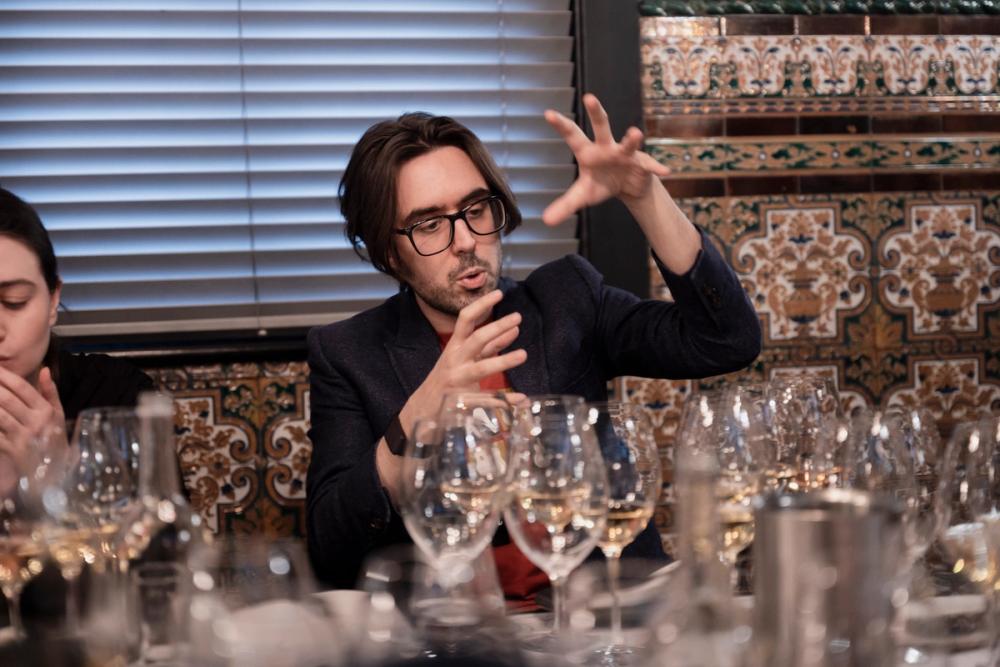
Swig's Nelson Pari said there has long been a reluctance in Italy to really get behind aged white wines
Before the debate what were your thoughts on the opportunities and potential for Italian aged white wines and heritage wines - did these change at all?
I think my opinions are still the same. It was great to see that the table was overall in line with all the main topics. We rarely were objecting to each other, as we mainly talked about the same point but in different ways and through different experiences. It was great.
What do you think can potentially give these wines an edge?
It is a double-edged sword between how exotic it is to discover unknown varieties against how much it could sell. The main edge these wines can have is all on price point; unfortunately Italy is already too expensive to compete with South Africa or Australia.
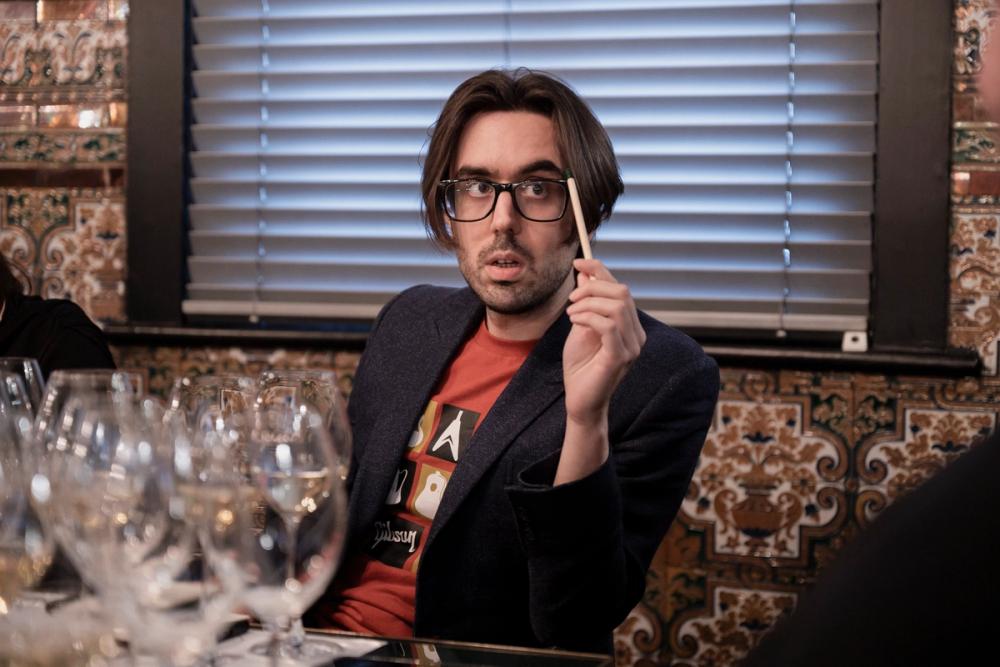
What are the challenges and things holding these wines back? Is it about quality, availability, price points, distribution?
Price and overall quality; they cost a lot and they're not always very good.
Do wines like the ones being made by Villa Bogdano have a place in the UK and if so where?
Depends on prices and how the marketing is done. They are pointing towards the fine wine market but the Lison DOCG is not that well known in the UK (and in Italy).
Anything else you would like to see Italian producers more with their aged white wines?
Increase the quality to match prices.
Tom Illsley, Theatre of Wine

Tom Illsley says Italian aged wines can attract a cult following
Before the debate what were your thoughts on the opportunities and potential for Italian aged white wines and heritage wines?
Only that I had fairly little experience of aged Italian white wines and that this largely highlighted the lack of fine Italian whites in the market. Most of the white Italian wines one encounters are simply meant for easy, immediate consumption. That said, any great wine should age and there must be the potential to make great white wine in Italy. Personally, Etna is where I see the greatest opportunity, but equally top Soave like Inama Foscarino has always shown class with a few years age and more structured wines like Emidio Pepe Trebbiano and the likes of Skerk in Friuli are magnificent examples of fine structured white wines from Italy that command a cult following.
On taking part in the debate did it change your thoughts on their opportunities?
To me it seems clear that there is plenty of wine in the market but there is always room for something good. If it is a wine of fine structure that benefits from a little age, that is great. I don't see age per se as anything other than indifferent, but I think it is axiomatic that a great wine must go beyond the easy pleasure of youth.

The buyers had the chance to taste a selection of aged white wines with food paired from Gaucho's menu
What do you think can potentially give these wines an edge?
I think it is entirely individual and as usual it is simply the combination of price and quality that will determine success.
Is it about quality, availability, price points, distribution?
Just quality and price, I think. I am sure that consumers would be very happy to drink anything provided it was excellent value. If a wine is aimed at the mass market, it must do much more to create a brand identity both for itself and for it's region or appellation. The success of Lugana relative to Custoza is a good example of this, but for fine wine I think it is much more important to have a good importer who understands the wine and to think about where you want the wines to be seen and how to get them there.
Do wines like the ones being made by Villa Bogdano have a place in the UK and if so where?
They were well made wines in a rich modern style. I think they would struggle to distinguish themselves from a myriad of similar wines and I would have loved for them to be a bit more traditional and distinctive to the place. It would be very hard, I think, tasting them to say what is the character either of Lison or of Friulano and that leaves them to fend for themselves on price alone, which tends to be a downward slope.
Anything else you would like to see Italian producers more with their white wines?
In famous growing areas that command a premium, like Soave, I think a move towards structure and a sense of terroir is crucial going forward. Too many of these wines simply test of the chemistry kit, of esters, cold fermentation and selected yeasts. Such wines could come from anywhere and if they are going to do anything towards establishing a region's credibility they have to aim higher.
What your overall thoughts on Italian white wines as part of the overall Italy category and what they are doing well?
One of the main reasons Italy has been particularly successful on white wines is their neutrality…easy drinking, nice, light, fresh and fruity. Those kinds of wines have attracted other cuisines, not only the Italian restaurant sector. Neutrality for me is also their main handicap. You drink it and it is not easy to remember what wine you have had.
Greg Sherwood, Museum Wines

Before the debate what were your thoughts on the opportunities and potential for Italian aged white wines and heritage wines?
As a wine merchant, I would normally only really look to source older, aged Italian white from producers that I had already tasted and knew aged well. The most classic examples being Cantina Terlaner which make incredible whites that age a very long time. But this point is key.
One of my favourite white wines in Italy is Cervaro della Sala, but it definitely drinks at its best within three to five years max - occasionally a little longer if it was a very fresh, cool, tight vintage. Else, there is little extra joy to be had by ageing it longer than three to five years.
Most of the ageable examples tend to come from cooler regions like Sud-Tirol, Alto-Adige and Friuli. So I normally look out for the aged versions with interest, especially if in an on-trade environment and I know I can return the bottle if it is knackered - or “not as it should taste” with age.
On taking part in the debate did it change/ adapt your thoughts on their opportunities?
To be honest, not really. But it perhaps did make me think there are more diverse regions and more diverse producers, outside of the usual candidates we all talk about, that might be worth considering in future.
What do you think can potentially give these wines an edge?
I think the Heritage Wines angle is new and interesting and would resonate with modern consumers. For me as a professional, looking to a specific vintage and vintage style would now be the more important consideration when looking for aged wines that are extra special. The cooler 2021 vintage style for example.
What are the challenges and things holding these wines back?
Even for professions, educating the consumer and the trade about which vintages are specifically primed for ageing (or that have been aged already) is key. Italy is a warm climate and not all vintages are age worthy. Blurring this message just results in consumers buying wines they liked young expecting them to age beneficially. Vintage conditions are key as well as how the wines are made. All comes back to eduction.
Is it about quality, availability, price points, distribution?
All wine enthusiasts would prefer to drink a wine with some age if they can be confident that the wine has improved with the extra cellaring. It then becomes incumbent on the producer and then the retail channel, be it a merchant or on-trade somm, to reassure the consumer that the aged version is worthy of extra interest and probably a slightly higher price than the youngest current release. If there is confidence, the higher price point would make sense to most people.
Do wines like the ones being made by Villa Bogdano have a place in the UK and if so where?
It takes time for wines to build a consumer brand profile. So for a winery like Bogdano, that I did not know of, the heavy lifting at this early stage of brand development would be best served establishing a presence for these wines in the on-trade. If they prove successful and popular with consumers, trickle down marketing will ensure that wine merchants in the off-trade retail sector with a high level of engagement will start to pick up on these types of wines and feel more confident to introduce them at a retail / shop level for consumers.
Anything else you would like to see Italian producers more with their white wines?
I would like to see Italian producers of fine white wines trumpet the cooler, fresher, more age worthy vintages more. Even regular buyers visiting Italy cannot be full up on which wine, grapes, producers and regions were particularly successful in a given vintage. But the message needs to be honestly tempered with the acknowledgment that not every white wine vintage should be aged particularly.
Anything else to say?
Interesting tasting. The aged wines matched the food probably better than the younger wines. So that is another positive angle.
Sergio de Luca, Enotria&Coe
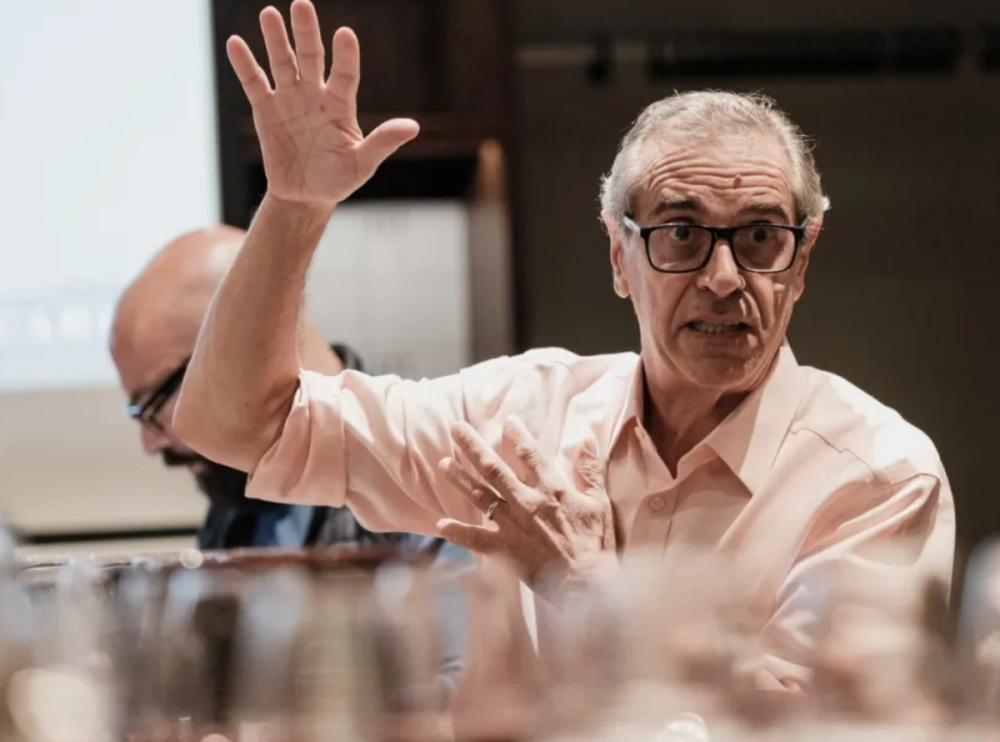
Enotria's hugely experienced Italian wine buyer Sergio de Luca
What are your thoughts on the opportunities and potential for Italian aged white wines and heritage wines?
This is something I really encourage. I have seen a trend in the past few years of white wines that are sold with some age and not just a month after the harvest. We are one of the main importers to believe strongly on Timorasso, but also, we have seen a good success with Carricante in Etna.
What do you think can potentially give these wines an edge?
Their structures give them a chance to get better with age.
What are the challenges and things holding aged Italian white wines back?
I believe it is a question of mentality connected with Italian producers. In the past there was a rush to sell their white wines as soon as the harvest finished. I remember getting Pinot Grigio in bottle in UK in November, two months after the harvest. That was also connected with finance, they did not have to stock their wines. If you ask for some library of white wines in Italy, there is not much there.
Do you have any in your range and if so why did you choose to work with them?
As I mentioned we put a lot of effort on Timorasso in Piedmont, up to the point we have, now, three wines in our range. Then we also work with Carricante (Etna Bianco). We are also pushing a Lugana Riserva from Ottella in the North Eastern Italy.
Is it about quality, availability, price points, distribution?
It is mainly availability. As I mention it is in the mind of producers, but due to a few people this mentality is changing. But there is also a price point situation. Sometimes they cannot compete with same quality wines from other countries on price.
What would you like to see more of?
I would like to see more aged whites become availabile, but at the same time price points have to be taken into consideration so they can be competitive.
* You can find out more about Villa Bogdano wines at its website here.


